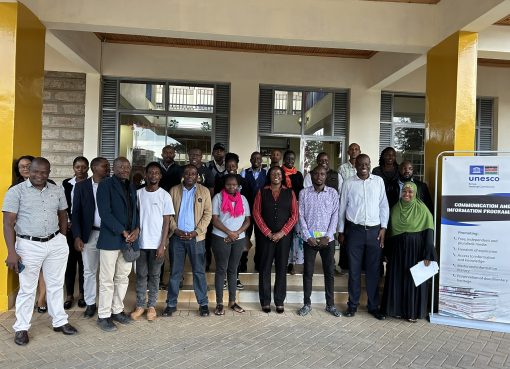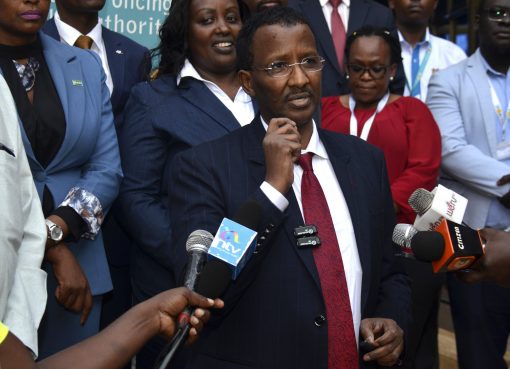On a cold night in mid-November 2016, police at a roadblock in Mwatate along Voi-Taveta highway flagged down two trailers packed with semi-dried animal hides destined for leather-processing industries in Nairobi.
An anonymous tip to the police had hinted at possible illegal cargo inside the sealed containers.
A probe revealed the containers had hundreds of plastic barrels concealed deep under the hides.
Chemical analysis would later establish the trailers had 45,000 liters of pure industrial-grade ethanol for illegal breweries that manufactured toxic concoctions that turned thousands of young Kenyans into alcoholic wrecks.
The ethanol, worth millions, had been smuggled across the porous border from neighbouring Tanzania.
The nabbing of the illicit cargo almost 100-km away from Kenya-Tanzania border raised critical questions on Kenya’s capacity to effectively protect her boundaries against influx harmful and contaminated imports from other countries.
Mohammed Washallah Abdi, a Voi-based development expert who is also the Deputy Secretary General for Supreme Council for Kenyan Muslims (SUPKEM), is candid. “The ethanol was a lucky chance. Our biggest concern should be on what else is coming through our boundaries without being detected,” he says.
Reports of illegal and dangerous goods finding their way into the country have become common. Even as the government works to stop the influx of illicit commodities and other harmful products by smugglers, unscrupulous traders and tax evaders who exploit the porous border, the problem persists.
Intensified scrutiny and enhanced surveillance at official entry points at sea, air and land border posts have not managed to completely stem the continued flow of hazardous goods pouring into the country. Officials blame this on existence of many illegal entry points along the border where security surveillance does not reach.
Geographically, Kenya shares land borders with five countries, including Sudan, Ethiopia, Uganda, Somalia and Tanzania. The total length of her international land boundary is 3,446km with an additional 1,420km of coastline.
The sheer size for land and sea boundaries presents a big challenge for border agencies. They include Immigration, Kenya Ports Authority, Kenya Revenue Authority, Kenya Bureau of Standards, Kenya Plant Health Inspectorate Service, Intelligence officials, police, Port health and livestock department amongst others.
Washallah says empowering such agencies should be a priority to ensure substandard imports never enter the country.
“These dangerous goods are sneaked in through our boundaries. Strengthening the capacity for border agencies to prevent such stuff from coming in our country should be a priority,” he explains.
He says the influx of counterfeits in Kenya poses the greatest risk to Kenya’s economic growth. He argues that the success of government’s Big 4 agenda depends on how well Kenya’s borders are protected noting that unchecked substandard and often cheap imports will ultimately kill local industries.
He warns that should an alien pest finds its way into the country, it would devastate the agricultural sector, cripple the economy and plunge the country into a food crisis.
“These are real threats out there that needs to be contained,” he adds.
To address such issues, Kenya has been working closely with the US government under Security Governance Initiative (SGI) program to secure her borders since 2014. Kenya is the only country in East African and one of the only six from Africa in this Obama-era multi-million dollar program whose objective is help countries address security and governance challenges.
Integrated Border Management was cited as a core area that needed support from the US government. Customs and Border Protection (CBP) experts have offered extensive training to agencies on border control, operations and protection with a focus on having a seamless coordination of their activities to achieve overall improved efficiency.
Under the program, Kenyan officials are also trained on chemical and biological analysis of imports at the ports to shield the country’s from alien pests and plants that might have an adverse effect environment and agro-forestry sectors.
Other benefits for Kenya from SGI, include receiving intelligence gathered by state-of-the-art surveillance technology like Container Targeting System (CTS) which traces ships with suspicious cargo globally. Other technologies include Automatic Targeting System which flags off individuals considered potential threats to national security. Plans are underway to help SGI partners set up National Targeting Centers and Passenger Analysis Units at the ports for enhanced screening of visitors coming in the country.
However, it is the introduction of strategic communication in border management to include the public in border management and security operations that promises to herald a new dawn for border control. Past border protection strategies failed to take into account the citizens’ role in securing a country’s borders. As a result, border operations became to be viewed as the sole responsibility of police and government officials.
In this new approach, members of public will be central to border protection in terms of gathering and passing intelligence on activities on their border regions to border agencies for action.
Eric Kiraithe, Principal Administrative Secretary at the Ministry of Information, Communication and Technology, says perception that border management is the mandate of police and other government agencies need to change.
He states that Kenyans should be involved in border security through awareness on the devastating effects porous borders is having on all aspects of their lives.
He cites examples of toxic consumables like substandard sugar, rice and other foodstuff which are smuggled in the country and eventually end up in dinner tables causing diseases that are too expensive to treat.
“It does not matter if you live in a border county or not. Kenyans must know the dangers of porous borders. Once the toxic products get into a country, everyone is at risk,” Kiraithe explains.
Bobby Pickett, a veteran US Customs and Border Protection (CBP) officer and the Bureau Chief, African, Middle East and Central Asia Division, Office of International Affairs, agrees. He says that a vigilant and well-informed public remains a formidable ally and the greatest asset for any country in border control activities. This is because a watchful citizenry complements the activities of border security agencies.
“They are central to border security. Citizens live in areas that might not be covered by border agencies. Once the people know the value of safe borders, they will be vigilant and will provide information on any suspicious activity in their area” he said.
However, Kenya has the unique challenge of dealing with cross-border communities that share blood ties. It is common to find relatives living on both sides of a country’s boundary and often cross over and back at will. The problem is common in all over 15 counties that shares a land boundary with neighboring countries. Such communities might not fully understand the dangers of open borders to a country.
Washalla says public education on such regions would enable people living in such areas to look at border operations differently.
“They should be told the dangers of ferrying in unchecked goods in the country even as they visit their kin,” he said.
This approach will be adopted through use of external communication strategy which has been cascaded to counties under Border Management Committees (BMCs). These are teams monitoring activities in their respective regions. The BMCs are expected to be releasing targeted communication to the public on importance of proper border management.
Once the public is on board, there are hopes that the tide on rampant influx of illicit cargo in the country will turn. Eventually, the US will use Kenya as a model for other countries in East and Central Africa on border management and protection.
By Wagema Mwangi



